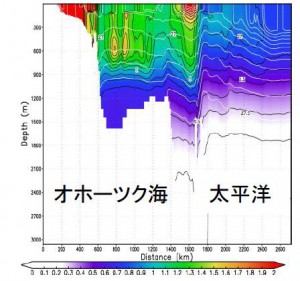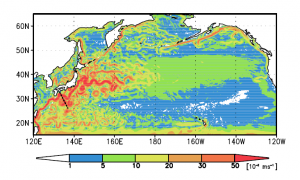Humio Mitsudera
Numerical modeling on biogeochemical circulation in the North Pacific Ocean
Research summary
Numerical modeling of materials circulation will be conducted aiming at elucidating mechanisms that cause abundant primary production in the western North Pacific Ocean, as well as in the Sea of Okhotsk and the Bering Sea. It is important to identify three dimensional oceanic pathways of nutrient materials, such as iron, from deep ocean to the sea surface where phytoplankton blooms. Specific research objectives are: (1) To elucidate roles of vertical mixing along the Kuril Islands, the Aleutian Islands and the Bering Sea Shelf on the three dimensional structure the nutrient pathways; (2) To develop high-resolution biogeochemical model that is forced directly by tides, as well as by wind and heat; (3) To elucidate impacts of long-term variations, such as the Pacific Decadal Oscillation and 18.6-year-period tidal oscillation, on biogeochemical cycles. The following two types of numerical models will be utilized to achieve these aims.
- A western North Pacific biogeochemical model with 0.5 ° resolution that includes enhanced tidal mixing along the Kuril Islands and the Aleutian Islands.
- A high-resolution North Pacific biogeochemical model that includes tidal forcing (Fig. 1 and Fig. 2).
The physical component of the former model has reproduced intermediate layer warming in the Sea of Okhotsk. Based on this model performance, numerical experiments will be conducted on seasonal and long-term variations of biogeochemical and iron cycles by utilizing the former model. The latter model is a novel one that will be developed during the years H28 and H29. Further, numerical experiments on the 18.6-year-period tidal forcing will be conducted with the latter model.

Fig.2 A preliminary result of the newly developed biogeochemical model. Intermediate-layer iron transport in the Sea of Okhotsk and the western North Pacific are reproduced.

Fig. 1 Strength of surface currents represented by the newly developed biogeochemical model. Fine structures such as western boundary currents and eddies are resolved quite well.
Principal Investigator:Humio Mitsudera (Institute of Low Temperature Science, Hokkaido University)

